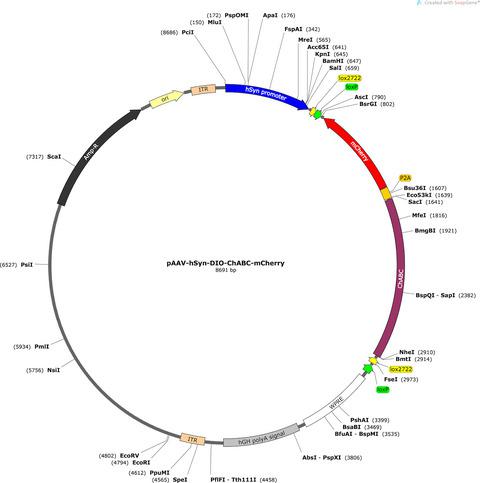当前位置:
X-MOL 学术
›
Eur. J. Nerosci.
›
论文详情
Our official English website, www.x-mol.net, welcomes your feedback! (Note: you will need to create a separate account there.)
Modified adeno-associated virus targets the bacterial enzyme chondroitinase ABC to select mouse neuronal populations in vivo using the Cre-LoxP system
European Journal of Neroscience ( IF 3.4 ) Pub Date : 2020-11-21 , DOI: 10.1111/ejn.15050 Kelly E Carstens 1 , Bernd R Gloss 1 , Georgia M Alexander 1 , Serena M Dudek 1
European Journal of Neroscience ( IF 3.4 ) Pub Date : 2020-11-21 , DOI: 10.1111/ejn.15050 Kelly E Carstens 1 , Bernd R Gloss 1 , Georgia M Alexander 1 , Serena M Dudek 1
Affiliation

|
Current methods of experimentally degrading the specialized extracellular matrix (ECM), perineuronal nets (PNNs) have several limitations. Genetic knockout of ECM components typically has only partial effects on PNNs, and knockout of the major ECM component aggrecan is lethal in mice. Direct injection of the chondroitinase ABC (ChABC) enzyme into the mammalian brain is effective at degrading PNNs in vivo but this method typically lacks consistent, localized spatial targeting of PNN degradation. PNNs also regenerate within weeks after a ChABC injection, thus limiting the ability to perform long-term studies. Previous work has demonstrated that viral delivery of ChABC in mammalian neurons can successfully degrade PNNs for much longer periods, but the effects are similarly diffuse beyond the injection site. In an effort to gain cell-specific targeting of ChABC, we designed an adeno-associated virus encoding ChABC under the control of the Cre-LoxP system. We show that this virus is effective at targeting the synthesis of ChABC to Cre-expressing mouse neurons in vivo. Although ChABC expression is localized to the Cre-expressing neurons, we also note that ChABC is apparently trafficked and secreted at projection sites, as was previously reported for the non-Cre dependent construct. Overall, this method allows for cell-specific targeting of ChABC and long-term degradation of PNNs, which will ultimately serve as an effective tool to study the function of cell-autonomous regulation of PNNs in vivo. This novel approach may also aid in determining whether specific, long-term PNN loss is an appropriate strategy for treatment of neurodevelopmental disorders associated with PNN pathology.
中文翻译:

改良的腺相关病毒靶向细菌酶软骨素酶 ABC,使用 Cre-LoxP 系统在体内选择小鼠神经元群
目前实验降解特化细胞外基质 (ECM)、神经周围网络 (PNN) 的方法有几个局限性。ECM 成分的基因敲除通常对 PNN 仅有部分影响,而主要 ECM 成分聚集蛋白聚糖的敲除对小鼠是致命的。将软骨素酶 ABC (ChABC) 酶直接注射到哺乳动物大脑中可有效降解体内 PNN,但这种方法通常缺乏一致的、局部的 PNN 降解空间靶向。PNN 在 ChABC 注射后数周内也会再生,从而限制了进行长期研究的能力。以前的工作表明,哺乳动物神经元中 ChABC 的病毒递送可以成功地降解 PNNs 更长的时间,但效果同样扩散到注射部位之外。为了获得 ChABC 的细胞特异性靶向,我们设计了一种在 Cre-LoxP 系统控制下编码 ChABC 的腺相关病毒。我们表明,这种病毒可有效地将 ChABC 的合成靶向体内表达 Cre 的小鼠神经元。虽然 ChABC 表达定位于表达 Cre 的神经元,但我们还注意到 ChABC 显然在投射位点被贩运和分泌,正如先前报道的非 Cre 依赖结构。总体而言,该方法允许 ChABC 的细胞特异性靶向和 PNN 的长期降解,这最终将成为研究 PNN 体内细胞自主调节功能的有效工具。这种新颖的方法也可能有助于确定是否具体,
更新日期:2020-11-21
中文翻译:

改良的腺相关病毒靶向细菌酶软骨素酶 ABC,使用 Cre-LoxP 系统在体内选择小鼠神经元群
目前实验降解特化细胞外基质 (ECM)、神经周围网络 (PNN) 的方法有几个局限性。ECM 成分的基因敲除通常对 PNN 仅有部分影响,而主要 ECM 成分聚集蛋白聚糖的敲除对小鼠是致命的。将软骨素酶 ABC (ChABC) 酶直接注射到哺乳动物大脑中可有效降解体内 PNN,但这种方法通常缺乏一致的、局部的 PNN 降解空间靶向。PNN 在 ChABC 注射后数周内也会再生,从而限制了进行长期研究的能力。以前的工作表明,哺乳动物神经元中 ChABC 的病毒递送可以成功地降解 PNNs 更长的时间,但效果同样扩散到注射部位之外。为了获得 ChABC 的细胞特异性靶向,我们设计了一种在 Cre-LoxP 系统控制下编码 ChABC 的腺相关病毒。我们表明,这种病毒可有效地将 ChABC 的合成靶向体内表达 Cre 的小鼠神经元。虽然 ChABC 表达定位于表达 Cre 的神经元,但我们还注意到 ChABC 显然在投射位点被贩运和分泌,正如先前报道的非 Cre 依赖结构。总体而言,该方法允许 ChABC 的细胞特异性靶向和 PNN 的长期降解,这最终将成为研究 PNN 体内细胞自主调节功能的有效工具。这种新颖的方法也可能有助于确定是否具体,



























 京公网安备 11010802027423号
京公网安备 11010802027423号